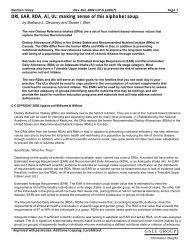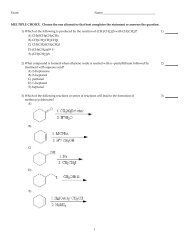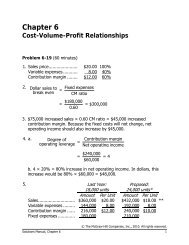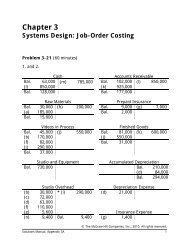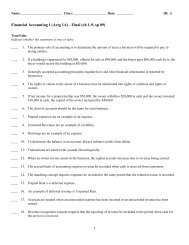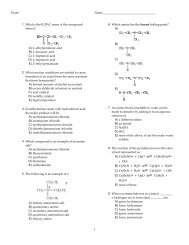Projectile and Satellite Motion - Fgamedia.org
Projectile and Satellite Motion - Fgamedia.org
Projectile and Satellite Motion - Fgamedia.org
You also want an ePaper? Increase the reach of your titles
YUMPU automatically turns print PDFs into web optimized ePapers that Google loves.
<strong>Projectile</strong> <strong>and</strong> <strong>Satellite</strong> <strong>Motion</strong><br />
1
<strong>Projectile</strong> <strong>Motion</strong><br />
• Without gravity, a tossed object follows a straightline<br />
path.<br />
• With gravity, the same object tossed at an angle<br />
follows a curved path.<br />
<strong>Projectile</strong>:<br />
• Any object that moves through the air or space<br />
under the influence of gravity, continuing in motion<br />
by its own inertia
Two-Dimensional <strong>Motion</strong><br />
• <strong>Motion</strong> in two dimensions can be modeled as two<br />
independent motions in each of the two perpendicular<br />
directions<br />
Any influence in the vertical<br />
direction does not affect the<br />
motion in the horizontal<br />
direction
<strong>Projectile</strong> <strong>Motion</strong><br />
<strong>Projectile</strong> motion is a combination of<br />
• a horizontal component, <strong>and</strong><br />
• a vertical component.
<strong>Projectile</strong> <strong>Motion</strong><br />
<strong>Projectile</strong>s launched horizontally<br />
Important points:<br />
Horizontal component of velocity doesn’t change<br />
(when air drag is negligible).<br />
• Ball travels the same horizontal<br />
distance in equal times (no<br />
component of gravitational<br />
force acting horizontally).<br />
• Remains constant.
<strong>Projectile</strong> <strong>Motion</strong><br />
• Vertical positions become farther apart with time.<br />
– Gravity acts downward, so ball accelerates downward.<br />
• Curvature of path is the combination of horizontal<br />
<strong>and</strong> vertical components of motion.
<strong>Projectile</strong> <strong>Motion</strong><br />
<strong>Projectile</strong>s launched at an angle:<br />
• Paths of stone thrown at an angle upward <strong>and</strong><br />
downward<br />
– Vertical <strong>and</strong> horizontal components are independent of<br />
each other.
<strong>Projectile</strong> <strong>Motion</strong><br />
• Paths of projectile following a<br />
parabolic trajectory<br />
– Horizontal component along<br />
trajectory remains unchanged.<br />
– Only vertical component<br />
changes.<br />
– Velocity at any point is<br />
computed with the Pythagorean<br />
theorem (diagonal of rectangle).
<strong>Projectile</strong> <strong>Motion</strong> Diagram<br />
Gravity only affects only the ball’s vertical motion<br />
A ball coasts horizontally while falling vertically<br />
The total velocity is the vector<br />
sum of the vertical velocity <strong>and</strong><br />
the horizontal velocity.
<strong>Projectile</strong> <strong>Motion</strong> – Implications<br />
• The vertical component of the velocity is zero at the<br />
maximum height of the trajectory<br />
• The acceleration stays the same throughout the<br />
trajectory
<strong>Projectile</strong> <strong>Motion</strong><br />
• Different horizontal distances<br />
– Same range is obtained from two different launching<br />
angles when the angles add up to 90°.<br />
• Object thrown at an angle of 60° has the same range as<br />
if it were thrown at an angle of 30°.
<strong>Projectile</strong> <strong>Motion</strong><br />
Different horizontal distances (continued)<br />
– Maximum range occurs for ideal launch at 45°.<br />
– With air resistance, the maximum range occurs for<br />
a baseball batted at less than 45° above the<br />
horizontal . o o<br />
( 25 − 34 )<br />
– With air resistance the maximum range occurs<br />
when a golf ball is hit at an angle less than 38°.
<strong>Projectile</strong> <strong>Motion</strong><br />
Without air resistance, the time<br />
for a projectile to reach<br />
maximum height is the same<br />
as the time for it to return to<br />
its initial level.
Question<br />
The velocity of a typical projectile can be represented by<br />
horizontal <strong>and</strong> vertical components. Assuming negligible air<br />
resistance, the horizontal component along the path of the<br />
projectile<br />
1. A. increases.<br />
2. decreases.<br />
3. remains the same.<br />
4. Not enough information.
Question<br />
As a ball thrown upward moves in its parabolic<br />
path, at which point along its path are the<br />
total velocity <strong>and</strong> acceleration perpendicular<br />
to each other<br />
1. nowhere<br />
2. The highest point<br />
3. The launch point<br />
15
Question<br />
As a ball thrown upward moves in its parabolic<br />
path, at which point along its path are the<br />
total velocity <strong>and</strong> acceleration parallel to<br />
each other<br />
1. nowhere<br />
2. The highest point<br />
3. The launch point<br />
16
Question<br />
Neglecting air drag, a ball tossed at an angle of 30° with<br />
the horizontal will go as far downrange as one that is<br />
tossed at the same speed at an angle of<br />
1. A. 45°.<br />
2. 60°.<br />
3. 75°.<br />
4. None of the above.
The <strong>Motion</strong> of <strong>Satellite</strong>s<br />
Gravity supplies the centripetal force<br />
http://www.youtube.com/watchv=uPxIXX_pPIQ (through 1:18)
Circular <strong>Satellite</strong> Orbits<br />
<strong>Satellite</strong> in circular orbit<br />
• Speed<br />
– must be great enough to ensure that<br />
its falling distance matches Earth’s<br />
curvature.<br />
– is constant—only direction changes.<br />
– is unchanged by gravity.
Circular <strong>Satellite</strong> Orbits<br />
• Positioning:<br />
beyond Earth’s atmosphere, where air resistance<br />
is almost totally absent<br />
Example: Space shuttles are<br />
launched to altitudes of 150<br />
kilometers or more, to be above<br />
air drag<br />
(But even the ISS, as shown<br />
experiences some air drag, which is<br />
compensated for with periodic upward<br />
boosts.)
Circular <strong>Satellite</strong> Orbits<br />
• <strong>Motion</strong><br />
moves in a direction perpendicular to the force of<br />
gravity acting on it<br />
• Period for complete orbit about Earth<br />
• for satellites close to Earth—about 90 minutes<br />
• for satellites at higher altitudes—longer periods<br />
http://www.youtube.com/watchv=YxRCyokN3g8&feature=related<br />
http://www.youtube.com/watchv=QqVg10OpjrA&feature=related
The <strong>Motion</strong> of <strong>Satellite</strong>s<br />
A satellite that goes around<br />
the earth once every 24<br />
hours is called a<br />
geosynchronous satellite.<br />
If a geosynchronous satellite<br />
is in an equatorial orbit, its<br />
position appears stationary<br />
with respect to a ground<br />
station, <strong>and</strong> it is known as a<br />
geostationary satellite.
Johannes Kepler<br />
• 1571 – 1630<br />
• German astronomer<br />
• He used data his mentor<br />
Brahe had collected on<br />
planetary motion to figure<br />
out the motion of planets.<br />
• He found that the motion of<br />
planets was not circular;<br />
rather, it was elliptical.<br />
http://www.youtube.com/watchv=lm9Ej-YMXto&feature=related<br />
Carl Sagan: http://www.youtube.com/watchv=GcKiG-CuvtA&feature=fvw
Kepler’s Laws of Planetary <strong>Motion</strong><br />
1 st Law: The path of each planet<br />
around the Sun is an ellipse with<br />
the Sun at one focus.<br />
2 nd Law: The line from the Sun to<br />
any planet sweeps out equal<br />
areas of space in equal time<br />
intervals.<br />
3 rd Law: The square of the orbital<br />
period of a planet is directly<br />
proportional to the cube of the<br />
average distance of the planet<br />
from the Sun (for all planets).
Ellipses
Kepler’s First Law<br />
• The path of each planet around the Sun is an<br />
ellipse with the Sun at one focus.<br />
• A circular orbit is a special type of elliptical<br />
orbit<br />
French Millionaire (I apologize for the title on the YouTube clip)<br />
http://www.youtube.com/watchv=fwQt1zsL1f8&feature=related
• The Sun is at one focus<br />
– Nothing is located at the other focus
Kepler’s Second Law<br />
The line from the Sun to any planet sweeps out<br />
equal areas of space in equal time intervals.<br />
http://www.youtube.com/watchv=_3OOK8a4l8Y&feature=related
Kepler’s Third Law<br />
• The square of the orbital period of a planet is directly<br />
proportional to the cube of the average distance of<br />
the planet from the Sun (T 2 ~r 3 for all planets)<br />
T<br />
2<br />
2<br />
⎛ 4π<br />
⎞<br />
3<br />
=<br />
⎜<br />
⎝ Gm<br />
sun<br />
⎟r<br />
⎠<br />
This is constant
Energy Conservation <strong>and</strong> <strong>Satellite</strong><br />
Recall the following:<br />
<strong>Motion</strong><br />
• Object in motion possesses KE due to its motion.<br />
• Object above Earth’s surface possesses PE by virtue<br />
of its position.<br />
• <strong>Satellite</strong> in orbit possesses KE <strong>and</strong> PE.<br />
– Sum of KE <strong>and</strong> PE is constant at all points in the orbit.
Energy Conservation <strong>and</strong> <strong>Satellite</strong><br />
<strong>Motion</strong><br />
PE, KE, <strong>and</strong> speed in circular<br />
orbit:<br />
– Unchanged.<br />
– distance between the satellite<br />
<strong>and</strong> center of the attracting<br />
body does not change—PE is<br />
the same everywhere.<br />
– no component of force acts<br />
along the direction of motion—<br />
no change in speed <strong>and</strong> KE.
Energy Conservation <strong>and</strong> <strong>Satellite</strong><br />
Elliptical Orbit Varies.<br />
<strong>Motion</strong><br />
– PE is greatest when the satellite is<br />
farthest away (apogee).<br />
– PE is least when the satellite is<br />
closest (perigee).<br />
– KE is least when PE is the most <strong>and</strong><br />
vice versa.<br />
– At every point in the orbit, sum of KE<br />
<strong>and</strong> PE is the same.
Escape Speed<br />
First probe to escape the solar system was<br />
Pioneer 10, launched from Earth in 1972.<br />
• Accomplished by directing the probe into the path of<br />
oncoming Jupiter





